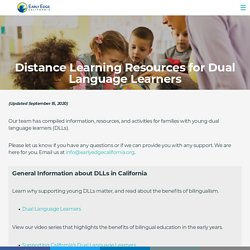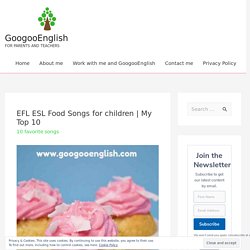

Games for Learning English, Vocabulary, Grammar Games, Activities, ESL. Listen to live Tegucigalpa radio on Radio Garden. Randall's ESL Cyber Listening Lab - English Listening. For English Language Teachers Around the World.
Early childhood education in English for speakers of other languages. Short stories for kids. CBeebies Global.
Google for Education: Teacher Center. FAQ: Raising Bilingual Children. Why want bilingual children? There are many reasons, but the two most common are: 1) The parents speak different languages (say, an American woman and a Turkish man). 2) The parents speak the same language, but live in a community where most people speak something else (say, a Korean couple living in the USA). In the first case, both the mother and father may want to be able to use their own language when talking to their children. This is the bilingual home situation. Don't children get confused when they hear two languages spoken around them?
The short answer is no. Fifty years ago educators throughout North America used to tell immigrant parents that it was better for their children's schooling if they spoke English at home. Bilingual development sometimes results in slightly slower language development than for some monolingual children. Don't bilingual children ever mix their languages up?
So how do we start teaching our children two languages? One problem can be balance. Relax. What is translanguaging? – EAL Journal. ‘Translanguaging’ – the use of different languages together – can be a powerful tool for learning … but it can also go against the grain for language teachers who are used to supporting learners to master the intricacies of a single language.

In this post, we ask what the research tells us about ‘translanguaging’ and how it can be used to support EAL learners in the classroom. Picture the scene: two students are sitting together, working intently on a handout. They have different first languages but some shared knowledge of the words and phrases of each other’s languages, so they are moving in and out of English to get their message across. Another two students are sitting together nearby.
Distance Learning Resources for Dual Language Learners – Early Edge California. Our team has compiled information, resources, and activities for families with young dual language learners (DLLs).

Please let us know if you have any questions or if we can provide you with any support. We are here for you. Email us at info@earlyedgecalifornia.org. For Families Screen-Free Activities to do at home with Children (in Spanish)Many of the resources below, recommended by Abriendo Puertas, emphasize the importance of mindful screen time, and encourage activities that do not require a device. Abriendo Puertas/Opening Doors has developed a video series as well as a list of helpful resources for organizations and families to help ease the stress and isolation during these times of physical distancing and quarantine. ABCMouse, is a full online curriculum developed by Age of Learning Inc. for children ages 2-8 in the areas of reading, math, science, and art and is available in both English and Spanish.
ABC Mouse. EJ1048612 - Supporting English and Spanish Literacy through a Family Literacy Program, School Community Journal, 2014. Family literacy studies have shown that the role of parental storybook reading has an impact on children's success in school-based literacy instruction.

However, many children who are English language learners come from homes or cultures where storybook readings are not common practice. The purpose of this qualitative research study explored the effects of an eight-week bilingual family literacy program for Latino, English learning families. Triangulation was assured through multiple sources of data: semistructured interviews conducted with participating parents; parent evaluation surveys; and researcher field notes. During the implementation of the bilingual family literacy program and the analysis of the data, three themes emerged: maintaining the first language, practicing what I have been taught, and the importance of time. Implications for educators are discussed. Academic Development Institute. 121 North Kickapoo Street, Lincoln, IL 62656. Find What Works! EFL ESL Food Songs for children. Are you hungry?

Do you like broccoli? Or do you prefer pizza? Important questions about food that your class will learn to answer and talk about with this fun selection of EFL ESL Food Songs for children. These are my favorite songs to use in class to teach food vocabulary, likes and dislikes, cooking actions and even food for animals. What’s your favorite food? Do You Like Broccoli Ice Cream? You probably all know this one and I had to start with it. Are You Hungry? An easy to sing song to introduce the question “Are you hungry?” I’m Hungry by Maple Leaf Learning This song looks at how to say what you want to eat when you’re hungry.
Vegetable Song by Singing Walrus Do you want to make some vegetable soup? Fruit Song for Children by Nursery Rhymes Songs This song is sung to the tune of The wheels on the bus. 5 Hungry Ants by The Kiboomers I did this song with my class of 3 year olds a few weeks ago and they absolutely loved it. Easy speaking - English ESL Worksheets for distance learning and physical classrooms.